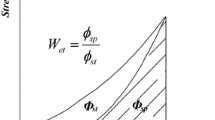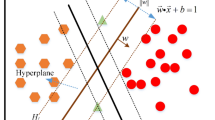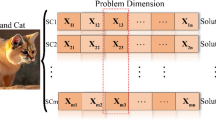Abstract
One of the utmost severe mining catastrophes in underground hard rock mines is rock burst phenomena. It can lead to damage to mine openings and equipment as well as trigger accidents or even threat to life as well. Due to this, a number of researchers are forced to study some easy-to-use alternative methods to predict the rock burst occurrence. Nevertheless, due to the extremely multifaceted relation between mechanical, geological and geometric factors of the mines, the conventional prediction methods are not able to produce accurate results. With the expansion of machine learning methods, a revolution in the rock burst occurrence has become imaginable. In present study, three machine learning methods, namely XGBoost, decision tree and support vector machine, are utilized to predict the occurrence of rock burst in various underground projects. A total of 134 rock burst events were gathered together from various published literatures comprising maximum tangential stress (MTS), elastic energy index (EEI), uniaxial compressive strength and uniaxial tensile stress (UTS) that have been used to develop various machine learning models. The performance of machine learning methods is evaluated based on the accuracy, sensitivity and specificity of the rock burst prediction.




Similar content being viewed by others
References
Wangen M (2019) A 3D model of hydraulic fracturing and microseismicity in anisotropic stress fields. Geomech Geophys Geo-energ Geo-resour 5:17–35. https://doi.org/10.1007/s40948-018-0096-4
Xu T, Yang T, Chen C, Liu HL, Yu QL (2015) Mining induced strata movement and roof behavior in underground coal mine. Geomech Geophys Geo-energ Geo-resour 1:79–89. https://doi.org/10.1007/s40948-015-0010-2
Afraei S, Shahriar K, Madani SH (2018) Statistical assessment of rock burst potential and contributions of considered predictor variables in the task. Tunn Undergr Space Technol 72:250–271
Li SJ, Feng XT, Li ZH, Chen B, Zhang C, Zhou H (2012) In situ monitoring of rockburst nucleation and evolution in the deeply buried tunnels of Jinping II hydropower station. Eng Geol 137-138(7):85–96
Miao SJ, Cai MF, Guo QF, Huang ZJ (2016) Rock burst prediction based on in-situ stress and energy accumulation theory. Int J Rock Mech Min Sci 83(2):86–94
Meng FZ, Zhou H, Wang ZQ et al (2016) Experimental study on the prediction of rockburst hazards induced by dynamic structural plane shearing in deeply buried hard rock tunnels. Int J Rock Mech Min Sci 86(2):210–223
Su GS, Shi YJ, Feng XT, Jiang J, Zhang J, Jiang Q (2018) True-triaxial experimental study of the evolutionary features of the acoustic emissions and sounds of rockburst processes. Rock Mech Rock Eng 51(2):375–389
Zhu QJ, Feng Y, Cai M, Liu JH, Wang HH (2017) Interpretation of the extent of hydraulic fracturing for rockburst prevention using microseismic monitoring data. J Nat Gas Sci Eng 38(6):107–119
Feng XT, Yu Y, Feng GL, Xiao Y-X, Chen B-R, Jiang Q (2016) Fractal behaviour of the microseismic energy associated with immediate rockbursts in deep, hard rock tunnels. Tunn Undergr Space Technol 51(1):98–107
Jiang LS, Wang P, Zhang PP, Zheng PQ, Xu B (2017) Numerical analysis of the effects induced by normal faults and dip angles on rock bursts. Comptes Rendus Mécanique 345(10):690–705
Zhang QY, Zhang XT, Wang ZC, Xiang W, Xue J (2017) Failure mechanism and numerical simulation of zonal disintegration around a deep tunnel under high stress. Int J Rock Mech Min Sci 93:344–355
Zhu WC, Li ZH, Zhu L, Tang CA (2010) Numerical simulation on rockburst of underground opening triggered by dynamic disturbance. Tunn Undergr Space Technol 25(5):587–599
Zhou J, Li X, Mitri HS (2016) Classification of rockburst in underground projects: comparison of ten supervised learning methods. J Comput Civ Eng 30(5):04016003
Pu Y, Apel D, Xu H (2018a) A principal component analysis/fuzzy comprehensive evaluation for rockburst potential in kimberlite. Pure Appl Geophys 175(6):2141–2151
Monjezi M, Mehrdanesh A, Malek A, Khandelwal M (2013a) Evaluation of effect of blast design parameters on flyrock using artificial neural networks. Neural Comput Applic 23(2):349–356. https://doi.org/10.1007/s00521-012-0917-2
Khandelwal M (2010) Evaluation and prediction of blast induced ground vibration using support vector machine. Int J Rock Mech Min Sci 47(3):509–516. https://doi.org/10.1016/j.ijrmms.2010.01.007
Ghasemi E, Gholizadeh H, Adoko AC (2020) Evaluation of rockburst occurrence and intensity in underground structures using decision tree approach. Eng Comput 36(1):213–225
Khandelwal M, Armaghani DJ, Faradonbeh RS, Ranjith PG, Ghoraba S (2016) A new model based on gene expression programming to estimate air flow in a single rock joint. Environ Earth Sci 75(9):739 1–13. https://doi.org/10.1007/s12665-016-5524-6
Duan J, Asteris PG, Nguyen H, Bui XN, Moayedi H (2020) A novel artificial intelligence technique to predict compressive strength of recycled aggregate concrete using ICA-XGBoost model. Eng Comput. https://doi.org/10.1007/s00366-020-01003-0
Zhou J, Asteris PG (2020) Danial Jahed Armaghani, Binh Thai Pham, Prediction of ground vibration induced by blasting operations through the use of the Bayesian network and random forest models. Soil Dyn Earthq Eng 139:106390
Khandelwal M, Marto A, Fatemi SA, Ghoroqi M, Armaghani DJ, Singh TN, Tabrizi O (2018) Implementing an ANN model optimized by genetic algorithm for estimating cohesion of limestone samples. Eng Comput 34(2):307–317. https://doi.org/10.1007/s00366-017-0541-y
Liao X, Manoj K, Yang H, Koopialipoor M, Murlidhar BR (2020) Effects of a proper feature selection on prediction and optimization of drilling rate using intelligent techniques. Eng Comput 36(2):499–510
Zhou J, Li X, Shi X (2012a) Long-term prediction model of rockburst in underground openings using heuristic algorithms and support vector machines. Saf Sci 50:629–644
M.R. Berthold, and D.J. Hand (2007) Intelligent data analysis: an introduction. Springer
Gong F, Li X, Zhang W (2010) Rock burst prediction of underground engineering based on Bayes discriminant analysis method. Rock Soil Mech 31(1):370–387
Su GS, Zhang XF, Yan LB (2008) Rockburst prediction method based on case reasoning pattern recognition. J Min Saf Eng 1:015
Sun J, Wang LG, Zhang H, Shen YF (2009) Application of fuzzy neural network in predicting the risk of rock burst. Procedia Earth Planet Sci 1(1):536–543
Dong L, Wesseloo J, Potvin Y, Li X (2016) Discrimination of mine seismic events and blasts using the fisher classifier, naive Bayesian classifier and logistic regression. Rock Mech Rock Eng 49(1):183–211
Zhang LW, Zhang DY, Li SC, Qiu DH (2012) Application of RBF neural network to rockburst prediction based on rough set theory. Rock Soil Mech 33(S1):270–276
Cai W, Dou L, Si G, Cao A, He J, Liu S (2016) A principal component analysis/fuzzy comprehensive evaluation model for coal burst liability assessment. Int J Rock Mech Min Sci 81:62–69
Jia Y, Lu Q, Shang Y (2013) Rock burst prediction using particle swarm optimization algorithm and general regression neural network. Chin J Rock Mech Eng 32(2):343–348
Pu Y, Apel DB, Lingga B (2018b) Rockburst prediction in kimberlite using decision tree with incomplete data. J Sustain Min 17(3):158–165
Y. Pu, D.B. Apel, C. Wang, and B. Wilson, Evaluation of burst liability in kimberlite using support vector machine, Acta Geophys (2018c), pp. 1-10
Monjezi M, Ahmadi Z, Varjani AY, Khandelwal M (2013b) Backbreak prediction in the Chadormalu iron mine using artificial neural network. Neural Comput Applic 23(3-4):1101–1107. https://doi.org/10.1007/s00521-012-1038-7
Asteris PG, Apostolopoulou M, Armaghani DJ, Cavaleri L, Chountalas AT, Guney D, Hajihassani M, Hasanipanah M, Khandelwal M, Karamani C, Koopialipoor M, Kotsonis E, Le T-T, Lourenço PB, Ly H-B, Moropoulou A, Nguyen H, Pham BT, Samui P, Zhou J (2020) On the metaheuristic models for the prediction of cement-metakaolin mortars compressive strength. Metaheuristic Comp Appl 1(1):63–99. https://doi.org/10.12989/mca.2020.1.1.063
Zhao Z, and Gross L, (2017) Using supervised machine learning to distinguish microseismic from noise events, Paper presented at the 2017 SEG international exposition and annual meeting
Feng X, Wang L (1994) Rockburst prediction based on neural networks. Trans Nonferrous Met Soc China 4(1):7–14
LX Zhang, CH Li (2009) Study on tendency analysis of rockburst and comprehensive prediction of different types of surrounding rock. Tang CA (ed), Proc 13th Int Symp Rockburst Seism Mines Rint Press Dalian, pp 1451–1456
Yi YL, Cao P, Pu CZ (2010) Multi-factorial comprehensive estimation for jinchuan’s deep typical rockburst tendency. Sci Technol Rev 28:76–80
Adoko AC, Gokceoglu C, Wu L, Zuo QJ (2013) Knowledge-based and data-driven fuzzy modeling for rockburst prediction. Int J Rock Mech Min Sci 61:86–95. https://doi.org/10.1016/j.ijrmms.2013.02.010
Dong L, Li X, Peng K (2013) Prediction of rockburst classification using random forest. Trans Nonferrous Metals Soc China 23:472–477. https://doi.org/10.1016/S1003-6326(13)62487-5
Kidybiński A (1981) Bursting liability indices of coal. Int J Rock Mech Min Sci Geomech Abstr 18(4:295–304
Dong L-J, Li X-B, Peng K (2013) Prediction of rockburst classification using Random Forest. Trans Nonferrous Metals Soc China 23(2):472–477. https://doi.org/10.1016/S1003-6326(13)62487-5
Faradonbeh RS, Taheri A (2019) Long-term prediction of rockburst hazard in deep underground openings using three robust data mining techniques. Eng Comput 35:659–675. https://doi.org/10.1007/s00366-018-0624-4
Prakash J, Kankar PK (2019) Health prediction of hydraulic cooling circuit using deep neural network with ensemble feature ranking technique. Measurement 2019:107225. https://doi.org/10.1016/j.measurement.2019.107225
Samantaray SR, Kamwa I, Joos G (2011) Decision tree based fault detection and classification in distance relaying. Eng Intell Syst 2:1–9
Upadhyay R, Manglick A, Reddy DK, Padhy PK, Kankar PK (2015) Channel optimization and nonlinear feature extraction for electroencephalogram signals classification. Comput Electr Eng 45:222–234
R. Shukla, , P. K. Kankar, and R. B. Pachori, Automated bearing fault classification based on discrete wavelet transform method, Life Cycle Reliab Saf Eng (2020), pp. 1-13.
Author information
Authors and Affiliations
Corresponding author
Ethics declarations
Conflict of Interest
The authors declare no competing interests.
Additional information
Publisher’s Note
Springer Nature remains neutral with regard to jurisdictional claims in published maps and institutional affiliations.
Rights and permissions
About this article
Cite this article
Shukla, R., Khandelwal, M. & Kankar, P.K. Prediction and Assessment of Rock Burst Using Various Meta-heuristic Approaches . Mining, Metallurgy & Exploration 38, 1375–1381 (2021). https://doi.org/10.1007/s42461-021-00415-w
Received:
Accepted:
Published:
Issue Date:
DOI: https://doi.org/10.1007/s42461-021-00415-w




